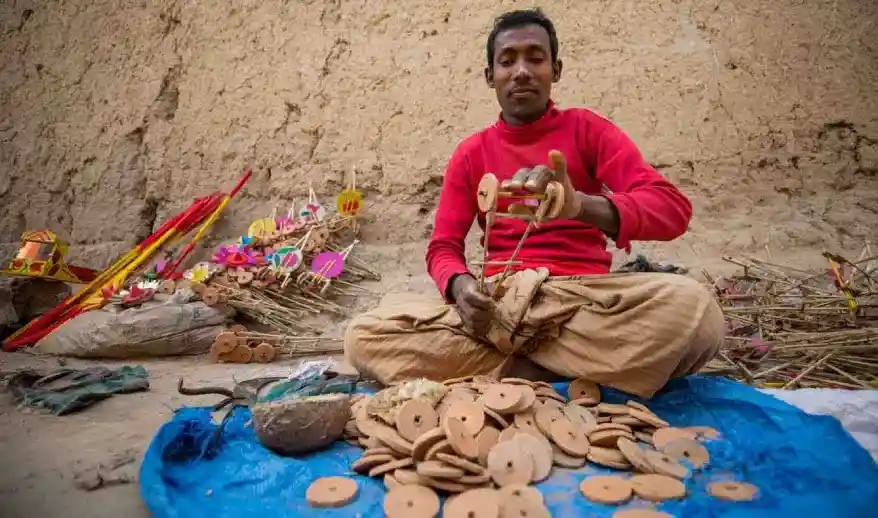Ashuganj’s Century-Old Rice Market Home / BOC Ghat sits about...
Read MoreExplore the Toy Village of Bangladesh and Its Craftsmanship
Explore Kholasha, the famous _ Toy Village in Bangladesh, where generations of artisans craft vibrant toys like Tom-Toms, Behala violins, and Charka carts, preserving a rich cultural tradition.
picturesque village wrapped in enchanting greenery. The breeze sways through fields of tender rice plants. This village, called Kholasha, is located in Dupchanchia, Bogura.
A lively flock of ducks splashes through the village ponds. In some homes, simple rural meals are being cooked over straw-fed clay stoves. Just 2 kilometers north of Dupchanchia town lies this peaceful Kholasha village.
In a few homes, the ancient tradition of spinning thread on a charkha still survives. It offers a chance for extra income alongside daily chores.
The women here are skilled in more than just housework—they weave nets, make fans, and craft fabric with impressive expertise.
But this village is famous across the country for a different reason. Its contribution to toy-making is recognized all over Bangladesh.
From children to young adults to the elderly—everyone in this “toy village” is closely involved in the craft.
The Beginning of Toy Village
About 60 to 70 years ago, during the time of Pakistan, the tradition of making Tom-Tom toys began in this village through a man named Kuranu.
As a child, Kuranu went missing and was later found by a group of Biharis in Saidpur. From them, he learned how to make Tom-Tom toys.
When he grew up, he returned to his village as a young man and started making the toys himself. Others in the village learned the craft from him—and that’s how it all began.
Tom-Tom or the Little Drum
The toy known as ‘Tom-Tom’ is made using clay for the body, wheels, thick paper, and bamboo sticks for wooden parts. In different regions, it’s also called Tortori or Van Gari (van cart).
When a child pulls it with a string, the thin bamboo stick strikes the thick paper, creating a drumming sound—just like a small drum. Around 200 families in this village are involved in making these handmade toys.
And more families are joining in regularly. Each household feels like a small cottage industry of its own.

Production at Toy Village
Thick paper is glued onto clay bowls and then dried in the sun. After drying, colorful designs are painted on the paper to make the toys more attractive.
A skilled artisan can produce around 400 Tom-Tom toys in a week. Each one costs about 7 to 10 Taka to make. The artisans sell them to wholesalers for 15 to 20 Taka, while retail prices range from 25 to 30 Taka.
Sales peak during festivals like the Boishakhi fair, Spring festivals, Durga Puja, and Eid-Ul-Fiter, when small village traders sell a large number of these toys.
It takes 39 hand-touches to complete just one toy. The soft drumming sound of the little Tom-Tom brings pure joy to a child’s imagination.
Behala – The Toy Violin
Alongside Tom-Toms, the village of Kholasha also produces a variety of other toys—wooden carts, wooden and plastic spinning wheels, wooden birds, toy violins (Behala), and Sarinda (a traditional string instrument).
Among them, the most popular is the toy Behala, made using clay, bamboo strips, and animal hide. It holds a special place in the world of handmade village toys.
The soothing melody of these toy violins stirs a unique emotion in people’s hearts. To craft a Behala, a bow shaped like a bent arrow is needed. Once a Behala is fully assembled, it’s always tested by playing it.
Charka Gari – The Spinner Cart
In this toy-making village, long-handled spinner carts (Charka Gari) are also crafted. The handles are cut to size and left to dry in the sun. Once dried, they are painted in bright, playful colors.
Since these are toys for children, the handles are usually pre-painted yellow and then decorated—red on one side, green on the other.
A plastic wheel with ridges is attached at the bottom, and on top sits a spinning disc with a small plastic bird. When children push the cart using the handle, the top disc spins with a curious, rhythmic sound.
Except during the monsoon months of Asharh, Shraban, and Bhadra (Name of 3 month of Bangla Calendar), the toy-making continues year-round in Kholasha village like an ongoing festival of creativity.
The Lives Behind the Toys
At first, they were a little shy. But eventually, three artisans from the eastern part of Kholasha’s toy village agreed to speak with us. One of them was Bulbuli Bewa, around 50 years old.
She was born here and got married in the same village. Bulbuli learned the craft from her father and still continues to make toys today. “This is my maternal home,” she says.
Together with her aunt and cousin, she makes Tom-Tom toys. Her cousin Jafar takes the finished toys to various fairs and sells them there.
According to the local traders, there are fairs happening somewhere in the country all year round. And thanks to steady demand, each Tom-Tom sells for around 20 Taka on average.
A single artisan can produce about 400 Tom-Toms a week. The highest sales happen during the Bengali New Year in the month of Boishakh.
The Culture of Eid al-Adha in Bangladesh
The Culture of Eid al-Adha in Bangladesh Eid al-Adha is...
Read MoreFishing Trawler Made in Bangladesh
Home / Fishing Trawler Made in Bangladesh About 10 kilometers...
Read MoreTop 7 Wonders of Bangladesh | 7 Wonders of the World
Home / Top 7 Wonders of Bangladesh Do you know...
Read More


